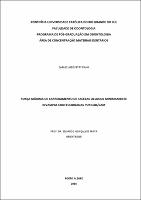| Share record |


|
Please use this identifier to cite or link to this item:
https://tede2.pucrs.br/tede2/handle/tede/7007| Document type: | Dissertação |
| Title: | Força máxima de carregamento de facetas oclusais minimamente invasivas confeccionadas por CAD/CAM |
| Author: | Petry Filho, Carlos José  |
| Advisor: | Mota, Eduardo Gonçalves |
| Abstract (native): | Objetivo: O objetivo deste estudo foi avaliar e comparar a força máxima de carregamento dos seguintes materiais: resina nanocerâmica, cerâmica dissilicato de lítio e a cerâmica silicato de lítio reforçada por dióxido de zircônio quando utilizadas como facetas oclusais em espessuras recomendadas pelo fabricante e com espessura reduzida de 0,6 mm, assim como avaliar os tipos e frequência de fraturas ocorrentes. Materiais e método: Aleatoriamente 56 terceiros molares extraídos hígidos foram divididos em 7 grupos de acordo com as variáveis material e espessura: grupo Controle (dente hígido); grupos L15 e L06 (Lava Ultimate) com 1,5 mm e 0,6 mm respectivamente, E15 e E06 (e.max CAD) com 1,5mm e 0,6mm respectivamente e S10 e S06 (Suprinity) com 1mm e 0,6 mm respectivamente. Cada material foi utilizado em duas espessuras, a espessura mínima recomendada pelo fabricante e 0,6mm. Todas as restaurações foram confeccionadas utilizando o sistema CAD/CAM CEREC. As peças receberam o tratamento pós fresagem de acordo com as recomendações dos fabricantes. Para condicionamento dos dentes foi utilizado ácido fosfórico 37% por 15 segundos de forma seletiva em esmalte, lavados por 30 segundos com água corrente e secos com jato de ar. O adesivo utilizado foi Single Bond Universal, aplicado de forma ativa por 20 segundos. Para a cimentação foi utilizado o cimento resinoso dual Relyx Ultimate. Resultados: Houve diferença estatisticamente significativa na relação entre o material utilizado e a força máxima de carregamento. A maior média de carga de carregamento registrada foi no grupo Controle 3428,25 N porém não diferiu estatisticamente do grupo L15, 2995,75 N. Os grupos E15, E06, S10 E S06 não apresentaram diferença estatística significativa, a menor média foi registrada no grupo S06 1330,68 N. Conclusões: Dentro das limitações de um estudo in vitro concluímos que o material interfere na força máxima de carregamento em facetas oclusais. No entanto, a redução das espessuras destes materiais não interferiu na força máxima de carregamento registrada quando comparado à indicação do fabricante. Foi possível observar que todos os materiais testados resistiram a uma força de carregamento superior à registrada em oclusão natural descrito na literatura. |
| Abstract (english): | Objective: The aims of this study were evaluate and compare the maximum load strength of the following materials: nanoceramic resin, lithium dissilicate ceramic and zirconium dioxide-reinforced lithium silicate ceramic when used as occlusal veneers in thicknesses recommended by the manufacturer and/or reduced to 0.6 mm, and the occurrence of fracture and fracture types. Materials and Method: Fifty six human molars extracted were randomly divided into 7 groups according to the material and thickness: Control group; L15 and L06 groups (Lava Ultimate), E15 and E06 (e.max CAD) and S10 and S06 (Suprinity). Each material was used in two thicknesses, the minimum thickness recommended by the manufacturer and 0.6mm. All restorations were made using CAD/CAM CEREC system. After milling, all samples were treated according to manufacturer’s recommendations and etched with hydrofluoric acid and silane when indicated. For teeth etching it was used 37% phosphoric acid for 15 seconds selectively enamel, washed for 30 seconds with water and dried with compressed air. The adhesive used was Single Bond Universal, applied actively for 20 seconds. For the cementation was used the dual cement Relyx Ultimate. Results: There was a statistically significant difference in the relationship between the material used and the maximum load strength. There was no significant difference between material and thickness within the groups. The largest recorded charging load average was 3428.25 N at Control Group however without statistically difference from the L15 group 2995.75 N. E15 groups, E06, S10 and S06 showed no statistically significant difference, the lowest average was recorded in group S06 1330.68 N. Conclusions: Within the limitations of this in vitro study, it is possible to concluded that material interfere in the maximum power load in occlusal veneers, however reducing the thickness of these materials does not affect the maximum force recorded charging, all materials recorded loading force greater than that recorded in natural occlusion. |
| Keywords: | RESINAS (ODONTOLOGIA) MATERIAIS DENTÁRIOS RESISTÊNCIA DOS MATERIAIS (ODONTOLOGIA) ODONTOLOGIA |
| CNPQ Knowledge Areas: | CIENCIAS DA SAUDE::ODONTOLOGIA |
| Language: | por |
| Country: | Brasil |
| Publisher: | Pontifícia Universidade Católica do Rio Grande do Sul |
| Institution Acronym: | PUCRS |
| Department: | Faculdade de Odontologia |
| Program: | Programa de Pós-Graduação em Odontologia |
| Access type: | Acesso Aberto |
| URI: | http://tede2.pucrs.br/tede2/handle/tede/7007 |
| Issue Date: | 29-Mar-2016 |
| Appears in Collections: | Programa de Pós-Graduação em Odontologia |
Files in This Item:
| File | Description | Size | Format | |
|---|---|---|---|---|
| DIS_CARLOS_JOSE_PETRY_FILHO_COMPLETO.pdf | Texto Completo | 990.63 kB | Adobe PDF |  Download/Open Preview |
Items in DSpace are protected by copyright, with all rights reserved, unless otherwise indicated.




